MONDAY
DECEMBER 30 - 2013
Hampshire
Farm
I have yet to visit
the newly completed forty acres of 'public open space'
at the housing development at Hampshire Farm to the
north of Emsworth. Chris Oakley was there yesterday
and had some pretty critical things to say about it.
Clearly, it is early days in the development of the
area, but Chris is disappointed in what he found
there. I would like to hear from anyone else who has
visited the site. Here is Chris's report with photos:
"It is now absolutely flat with newly sown grass which
gives it the appearance of a field of winter wheat.
There is a token planting of unrecognisable twigs,
each with their plastic tube, at the Long Copse Lane
end.
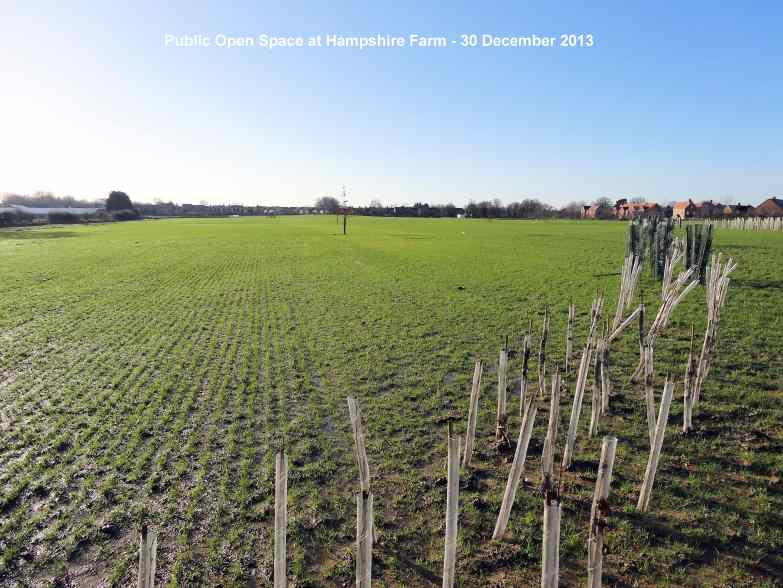
"I found no sign of
wildlife whatsoever except just outside the eastern
fence along the meadow edge north of the Wren centre
where I put up a Heron and a cock Pheasant. Along this
hedge-line there is a twenty foot strip which could
well produce a good selection of plants in the coming
year. There being no animal cover at all, I cannot see
that there will be much wildlife for some years. There
was no sign of deer trod or fox prints. Here, last
year, when it was still a wilderness, there were
several Roe deer and a family of foxes.
"The attenuation pond
at the southern end by Westbourne Road was deserted.
Yet again, last year it was a favourite haunt of many
birds including of a pair of Shelduck who stayed all
summer and a pair of Great Black-backed Gulls. I did
wonder if it was the same pair which nested on the
Slipper Millpond. Luckily I did get some good shots of
House Martins back in June as they gathered mud along
the water edge. I was much saddened by the
unsympathetic treatment of this area which had so much
potential as a wild preserve."
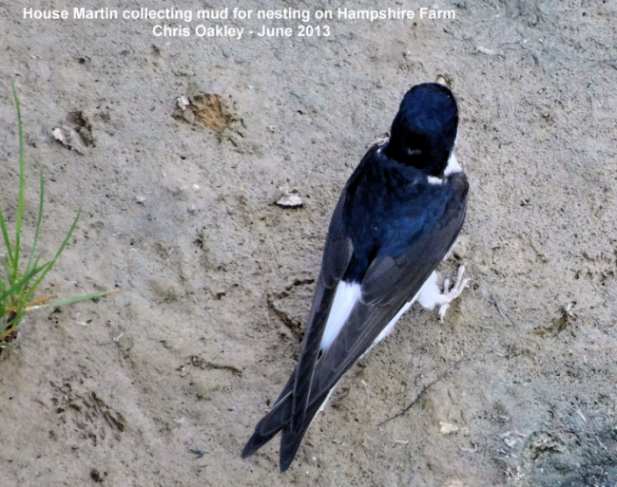
SATURDAY
DECEMBER 28 - 2013
Blackbird
song
A Blackbird was
singing its full rich song from a tree at the back of
Bridge Road car park when I walked through at 11am
this morning. Blackbird is an infrequent singer in
winter. This was the second I have heard in Emsworth,
the first being on Dec 6 from a tree in West Street.
Ralph Hollins also heard one in full song on Dec 11 in
Havant.
Brook
Meadow
Walking through Brook
Meadow a little later later I was hoping I might get
to hear another Blackbird, but though I heard several
birds giving their rattling calls there was no further
song. However, several Robins were in good voice
around the meadow, plus the occasional Wren, with
Woodpigeon and Stock Dove singing from the railway
embankment. Dunnock was calling but not singing, Great
Tit scalding and Magpies chattering were the other
main sounds on Brook Meadow.
What I assume was the
same Grey Heron that Brian Lawrence and I saw on the
meadow yesterday, was fishing in the tunnel beneath
the railway. A group of up to 12 House Sparrows was
busily feeding on the north path, moving between the
dense bramble bushes and the path as is their custom.
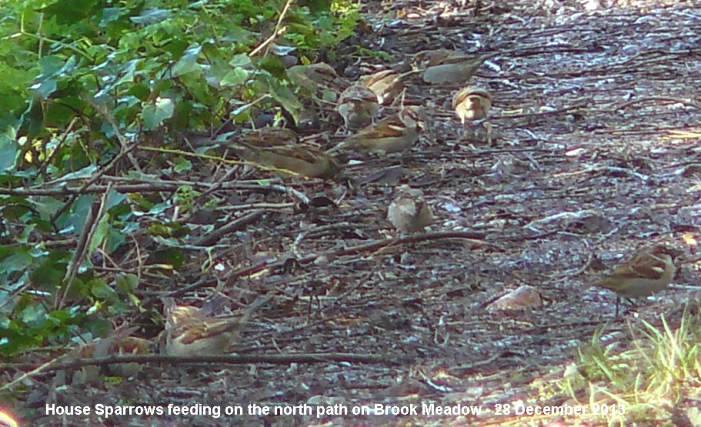
I was amused to see a
Dunnock come up from the river bank with a small worm
in its bill only to be chased into the brambles by
some House Sparrows.
Waysides
News
Ralph Hollins made a
more interesting discovery on the Warblington
Underpass wayside (which is the east of the
underpass). This was what he thought could be a plant
of Blue Fleabane with lots of flower heads
though none had as yet put out the ray florets which
give the plant its distinctive blue colour. This
plants would certainly be an addition to the flower
list for this Emsworth Wayside site. Ralph also found
Field Madder in flower and at the far end of the
underpass tunnel two Gorse bushes both had fresh
flowers. Ralph provided this link to the a photo of
Blue Fleabane from the internet http://www.eastlondonnature.co.uk/wp-content/files_mf/13321038831291500077ErigeronacerBlueFleabaneCRW_2706.jpg
Havant
Town Millpond
Ralph Hollins also
gave some information and a sketch map of the old
Havant Town Millpond, now severely truncated to a
small pond on the east side of Park Road South
opposite the Solent Road junction leading to Tesco's.
Interestingly, this is where Water Voles have been
seen on several occasions this year. See
http://ralph-hollins.net/Diary.htm
Fri Dec 27.
FRIDAY
DECEMBER 27 - 2013
Grey
Heron on Brook Meadow
The only bird of
interest on Brook Meadow today was a Grey Heron that I
disturbed as it was fishing in the River Ems near the
north bridge. It was still around later when Brian
Lawrence got this rather nice photo of it. Grey Heron
is not an unusual bird on Brook Meadow, but in fact
this is the first ever photo we have had of one on the
meadow. So, well done, Brian.
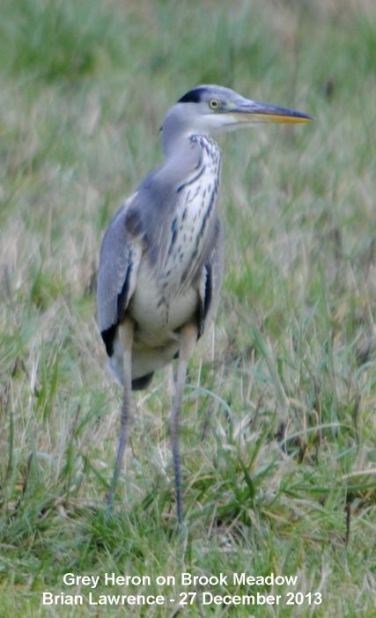
THURSDAY
DECEMBER 26 - 2013
Kingfisher
on Peter Pond
This morning I had a
walk through Brook Meadow and down to Gooseberry
Cottage where the flooding had subsided. Looking
across Peter Pond from the A259 I spotted a Kingfisher
perched on the bird table that David Gattrell has
strategically placed in front of the northern reedbed.
It was a long way away, but here is my best photo with
my 12x zoom Lumix. By the time I had walked back down
the path towards Gooseberry Cottage it had flown.
Brian Lawrence told me he had seen one on this table a
couple of weeks ago, so this should be a good spot to
see one. Ros Norton also saw one Peter Pond on Dec 2.
This was my first Kingfisher of the winter.
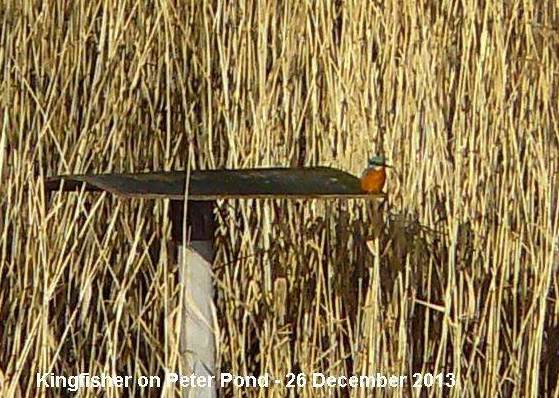
Water
Rail on Baffins Pond
Eric Eddles had a good
sighting of a Water Rail on Baffins Pond, Portsmouth
this morning. Baffins Pond is a particularly good
place to see and photograph this normally very elusive
bird. Eric also saw a pair of Chiffchaffs in the reed
bed on the south east corner of the pond.
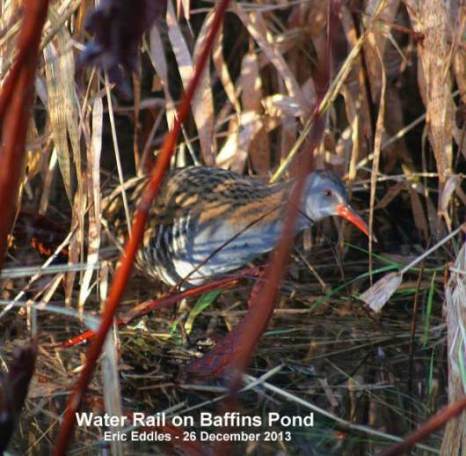
WEDNESDAY
DECEMBER 25 - 2013
Swans
on millpond
John Vickers was
interested to see at least ten swans, plus the cygnet,
on the pond this morning. He wonders if the weather
conditions have begun to tempt them back. In any case
the cygnet seems to be pretty independent of its
parents now.
I think it will be
interesting to watch what happens as spring
approaches. There does seem to be a fairly determined
pair of intruders that are vying for dominance with
the pair that nested here last spring. There could be
trouble ahead!
More
flooding
In addition to
yesterday's news of flooding around Emsworth, Anne de
Potier added that Selangor Avenue and the garage on
the corner of Nore Farm Avenue also got it bad again,
and some the houses at the north end of Barn Close are
unable to flush their loos as the drains won't take
any more fluid.
Hayling
beach combing
We are very grateful
to Chris and Ann Oakley for drawing to our attention
the great variety of objects that the recent stormy
weather has thrown up onto our beaches. They went for
a Christmas morning walk along Hayling beach and found
. . . "a beach comber's paradise". There were still
lots of Whelk egg cases but today these were
outnumbered by hundreds of Starfish, as well as Sea
Urchins, Sea Anemones, Sea Slugs, sponges, Mermaids'
purses (mostly Dogfish) and all sorts of detritus both
natural and human. They also found a six legged
Starfish and wondered if this was a variety or a kind
of nautical lucky four-leaved clover? Does anyone
know?
Sea Urchin tests or
skeletons are what is left when the animal dies. The
white tubicles are where the spines were attached and
radiating lines of small holes where the tube feet
projected.

Mermaids' purses are
the horny egg capsules of skates, dogfish and rays.
They are 2-10cm long, roughly rectangular with a bulge
in the middle and, in the case of dogfish, with long
tendrils that help the capsule attach to seaweed. The
egg capsule is tough enough to survive the 5-11 months
needed before the hatchlings emerge. The natural
habitat for dogfish purses is attached to seaweed
below the waterline. However, they are often washed
inshore where the developing embryo has little
likelihood of surviving.

Although Starfish live
underwater they are not fish. They do not have gills,
scales, or fins like fish do and they move quite
differently from fish. While fish propel themselves
with their tails, sea stars have tiny tube feet to
help them move along. Apparently, thousands of dead
Starfish have been washed up on the beaches of Kent
and Sussex in the past week.
Here is a link to a Daily Mail report . . .
http://www.dailymail.co.uk/news/article-540137/Starmageddon-As-thousands-starfish-wash-beaches-blame-destroying-natures-little-marvels.html
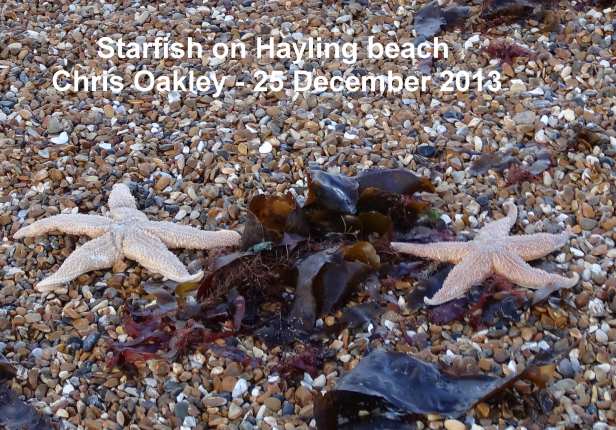
Not all sea stars have
5 arms. While the five-armed varieties of sea star are
the most well known some have many more, eg the sun
star has up to 40 arms! Also, the starfish is able to
regenerate arms that are lost. This might account for
Chris's strange six armed creature
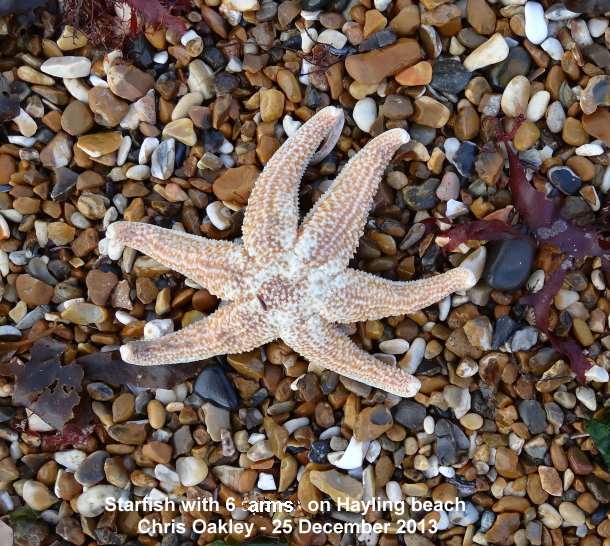
TUESDAY
DECEMBER 24 - 2013
FLOODS
IN EMSWORTH
Bridge
Road
Last night's storm
produced flooding in the Emsworth area. I live in
Bridge Road which has been particularly vulnerable in
the past to flooding from the Westbrook Stream which
runs to the east of the road. Our back garden was
flooded when we got up this morning, but it did not
touch the house and gradually drained away. Bridge
Road itself was not flooded when I walked down later,
though a local householder told me that there was a
bad flood early this morning which covered the south
end of the road and the car park. However, unlike in
previous years, the flood waters quickly cleared. The
Environment Agency clearly have cracked this
particular problem by making sure the culvert is large
enough to take the flood water into the millpond,
which itself is kept empty at critical times. I was
amazed at the huge pile of debris that the workers had
cleared from the grill at the end of St James Road.

Brook
Meadow
I had a phone call
this morning from Pam Phillips to say the meadow was
flooded like she'd never seen it before. So, I put on
my wellies and went over with the camera. The main
river was raging and the south meadow totally flooded
like I have not seen since the big flood in Year 2000.
The lower part of the south meadow near the south gate
was waist deep in water, reaching almost up to the
signcase window. The river had also flooded Palmer's
Road Copse and the path was completely inaccessible.

Gooseberry
Cottage
The biggest shock was
to see Gooseberry Cottage in the centre of a lake with
the garden totally flooded. It has never been this bad
since year 2000. This photo was taken from the path
near the Lumley Gate on Brook Meadow looking across
the garden of Gooseberry Cottage.
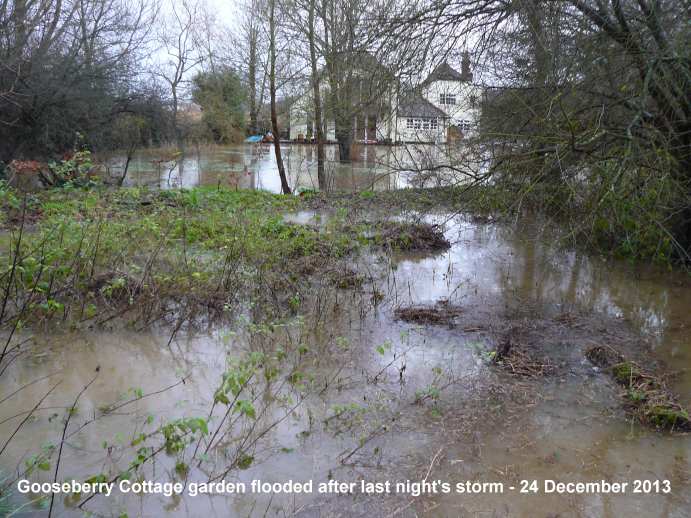
I spoke to Verity
Ingrams who owns the cottage and she confirmed that
the new section of the house, which had been built
higher than the old house, had been inundated for the
time ever. This photo shows the old part of Gooseberry
Cottage.
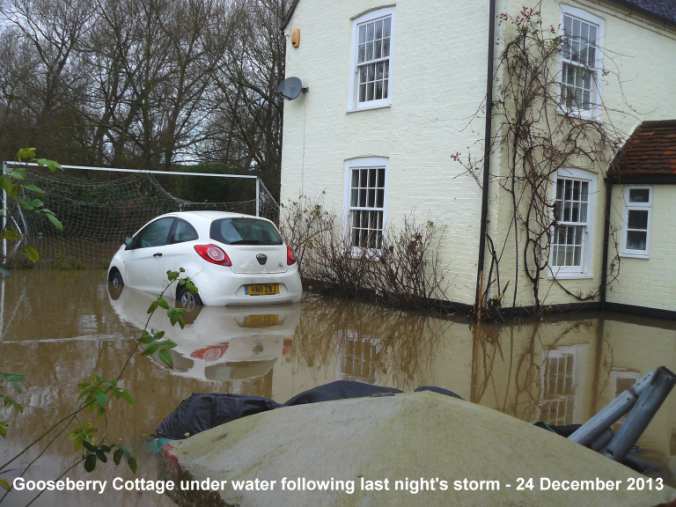
There was a fire
engine present when I passed that was pumping out the
house.

Other
areas
Lumley Road was also
flooded, though this is not unusual. The bottom of
Queen Street was fairly clear of water by the time I
arrived at about 10am. Houses at the bottom of Brook
Gardens had also been flooded by water pouring down
the street from the stream which runs to the west of
the houses. This is the stream that runs into the
harbour at Nore Barn. See . . . http://www.portsmouth.co.uk/news/local/floods-hit-emsworth-1-5769311
Finally, a nice image
to end on was the flowering of Winter Heliotrope on
the south west corner of Peter Pond.

SUNDAY
DECEMBER 22 - 2013
Update
on Hogboy the Hedgehog
Graham Petrie provided
the following up date on the Hedgehog he is looking
after, which he has named Hogboy. See previous posting
on Dec 12. "Hogboy is now weighing in at 556 grams as
shown in the following photo. The weight increase
stalled for a couple of days before we realised to up
his food intake, he seems good, not coughing at the
moment. "
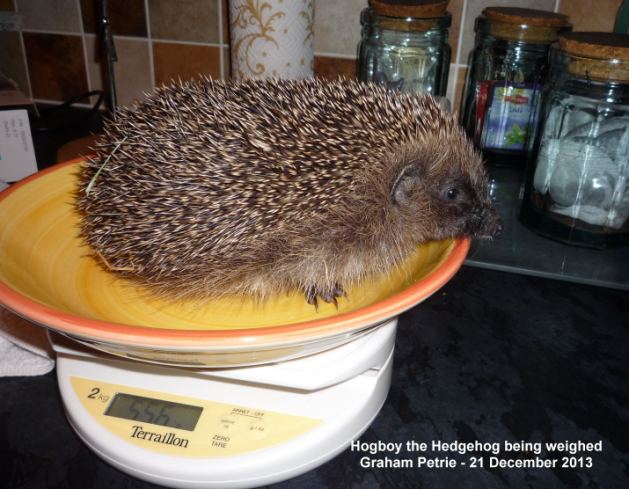
"Interesting to see
BBC news this week agreeing with some of my earlier
comments regarding the late broods due to the mild
weather, hopefully will save a few more if people are
more aware. The little guy does need some looking
after, a full clean out every two days, and regular
water changes, he has a tendency to wee and poo in his
own food and drink, probably trying to tell us
something!"
SATURDAY
DECEMBER 21 - 2013
Personal
note
I had an hour on the
operating table yesterday afternoon with the surgeon
sewing everything back together after the removal of a
tumour from the eyelid of my right eye. Hopefully all
is now clear and the healing process can get going.
But the patch is back on and, as a result, my wildlife
watching is much curtailed. The following observations
were made yesterday morning, but I did not feel like
doing the blog. But here it is slightly delayed.
FRIDAY
DECEMBER 20 - 2013
NORE
BARN
10:30 -11:30 - I got
to Nore Barn with the tide rising quickly to high
water at 13:00. The mouth of the stream was crowded
with birds as it usually is with Brent Geese, Wigeon
and Black-tailed Godwits dominating along with the
regular flock of 12 Mute Swans. The Spotted Redshank
was feeding alone in the shallow waters of the upper
stream throughout my visit. It flew off just as I was
leaving at about 11:30. A Rock Pipit came onto the
beach when I was watching the godwits, but it was too
quick for me to get a photo. Peter Milinets-Raby has
also had one in this area on Dec 14.
Brent
Geese
I watched several
skeins of Brent Geese fly overhead from the harbour to
come down on the fields to the west of Maisemore
Gardens. The photo shows one such skein coming down
over the thicket north of Nore Barn.
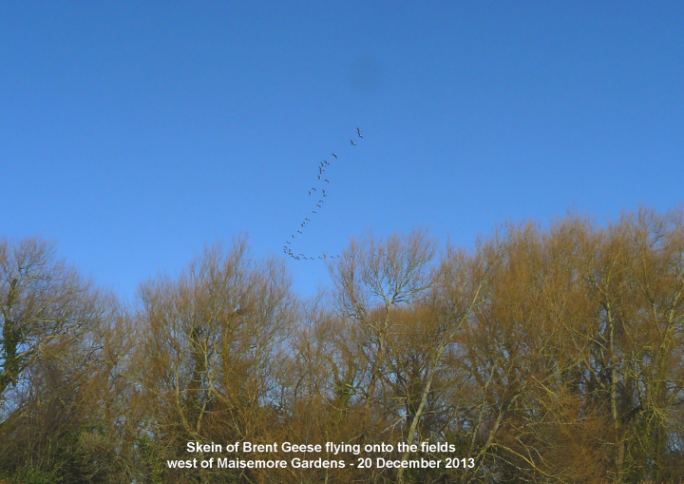
John Norton was also
in the area and saw the flock of 350 Brent Geese
tucked into the NE corner of the large arable field
next to Barn Close and mostly hidden from view from
the footpath to the west (Grid Ref: SU 737057). John
found a strongly marked Black Brant at the edge
of the Brent flock on higher ground, presumably the
one that Peter Milinets-Raby saw on 14th.
Black-tailed
Godwits
I counted a total of
86 Black-tailed Godwits. As many of them were feeding
in water I was only able to check about half of them
for colour-rings and found 5 with rings. G+WR, R+GL,
R+YN and WO+LW flag are all regulars in Emsworth this
winter, but L+LN was one I have not seen here since
last August. It has been to Kent in the meantime where
Dudley Hird recorded it on 25-Sep-13. Lots of
'spurting' was going on while the godwits were feeding
in water. Here is just one example.
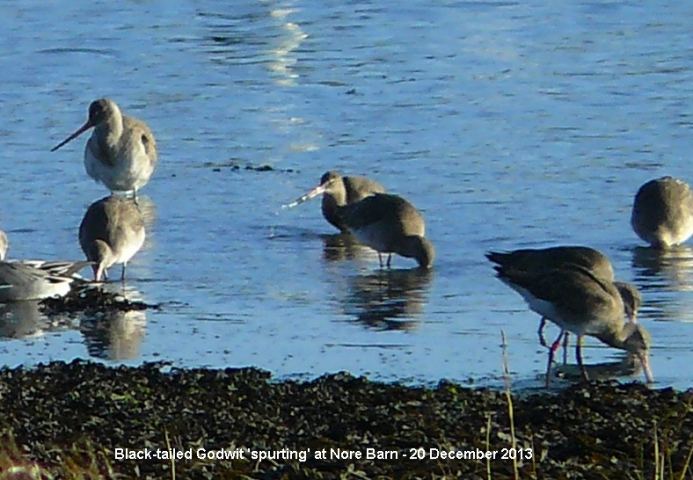
Whelk
egg-case
I spotted a Whelk
egg-case on the shore near the end of Warblington
Road. It is yellowish in colour suggesting the
presence of young embryos. Chris and Ann Oakley found
large numbers of these egg-cases washed up on Hayling
beach yesterday - see yesterday's entry for photo.
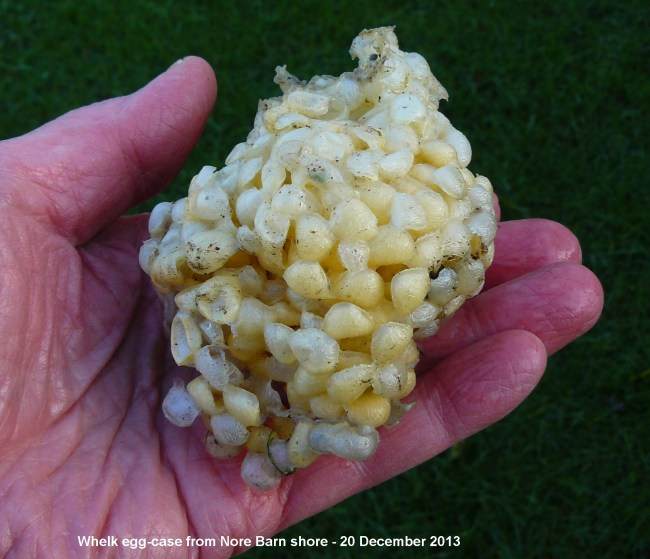
OTHER
NEWS
Brian Lawrence got
this image of a Cormorant struggling with what looks
like a Flounder fish on Peter Pond. Brian said the
bird did manage to swallow the fish in the end.
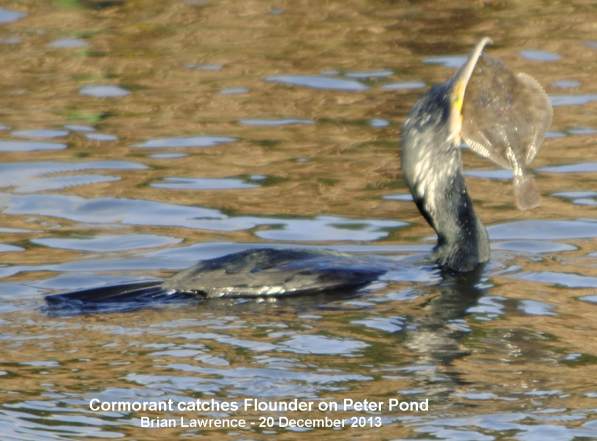
Romney Turner was on
Farlington Marshes where she caught this small group
of Oystercatchers flying overhead.

THURSDAY
DECEMBER 19 - 2013
BROOK
MEADOW
Conservation
work session
I went over to Brook
Meadow this morning mainly to take some photos of the
work session. Ten volunteers were present on a fine
morning. Here they are ready to go with their spades.
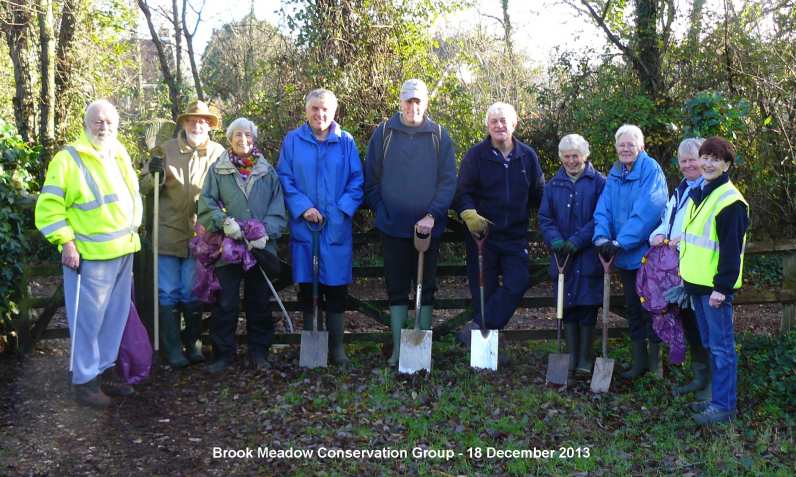
The meadow was very
wet after last night's rain, so the work took place on
high ground. The main jobs were clearing grass from
the steps behind the seat and from the main river path
and litter picking.
Wildlife
observations
A Song Thrush was
singing strongly from the Lumley area when I arrived.
I noticed the first Winter Heliotrope flowers of the
winter on Brook Meadow were open on the edge of the
main path just north of the sluice gate.
Christmas
party
After the work session
we were invited to Ted and Penny's place for the
traditional mulled wine and mince pies which were very
good indeed. The group presented both Penny and me
with Christmas gifts in gratitude of the our
contribution to the conservation project over the past
14 years. Here am I (wounded eye and bag of gifts)
with Ted enjoying a glass or two!

A full report of the
work session plus more photos are on the Brook Meadow
web site at . . .
http://www.brook-meadow.hampshire.org.uk/bm-diary-2013.html
HAYLING BEACH
Birds
Chris and Ann Oakley
had a walk along Hayling beach this morning. It was a
perfect winters day with great rollers pounding up the
shore. It is certainly a great beach for waves. They
watched Herring Gulls and Carrion Crows chasing the
waves for food and a small flock of Sanderling with a
few Turnstone skittering along the waters edge.
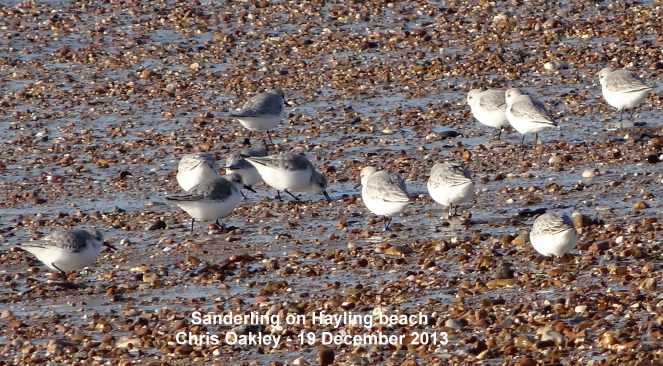
They were surprised at
just how many of the Sanderling were carrying
identification rings, red, blue, yellow and white, in
various combinations. These were most likely from the
big catch of Sanderling and Ringed Plover by Pete
Potts and his ringing team at Black Point on 22 Sep
2011.
Whelk
egg cases
Chris and Ann also
noted an astonishing number of Whelk egg cases
scattered over the beach, looking a bit like bath
sponges. They were washed up on the beach by last
night's storm.
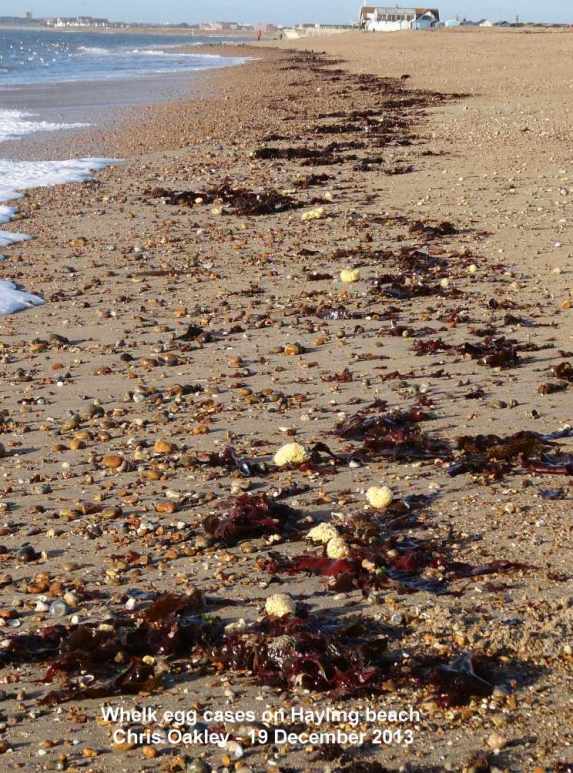
These cases look
yellow in the photo which probably means there are
some baby Whelks still inside; they would be grey if
the whelks had already hatched. This must account for
the fact that gulls and crows were pecking at them,
looking for the odd left over embryo. One interesting
feature about baby Whelks is that they are
cannibalistic; the first whelks to hatch feed on the
other eggs until only about 10 fully formed young
finally emerge from the original 1,000 eggs that were
laid.
WEDNESDAY
DECEMBER 18 - 2013
Coots
in harbour
During a walk around
Emsworth Millpond this morning I noted the first signs
of a build up of wintering Coot in the harbour. There
were just 13 Coot this morning near the quay and
another 12 outside the marina entrance, but I expect
numbers to build up as winter progresses and inland
lakes freeze up.
Garden
Greenfinch slump
The latest issue of
Bird Table, the BTO magazine for Garden BirdWatchers
reports a big decline in Greenfinches at garden
feeding stations. Although the overall fall in
Greenfinch reporting rate since the outbreak of
trichomonosis disease in 2006 has levelled off in
recent years (ie participants recording the birds as
present) the mean flock size has reached its lowest
level ever at about 1.5. Another thing also stands out
in the figures which is the lack of any autumn
increase in Greenfinch numbers that used to be an
important feature of Garden BirdWatch counts. What
this indicates is that overall the Greenfinch
population has severely diminished though a few still
survive.
The overall BTO
results are mirrored by my own garden counts as shown
in the following chart which shows how the mean weekly
count of Greenfinches over the year has dropped from
9.6 in 2006 to 0.5 last year.
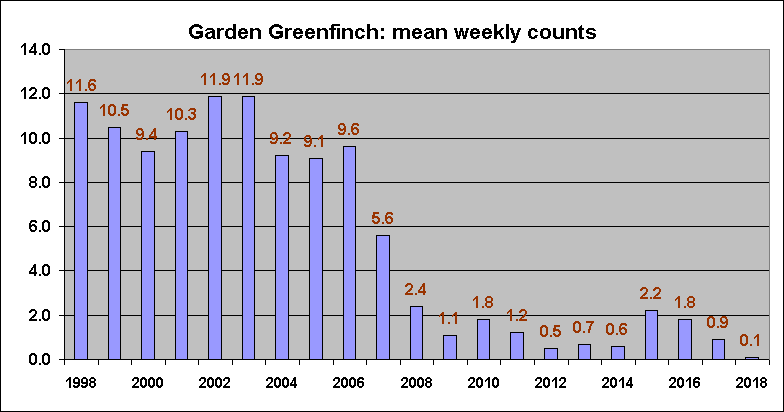
This year's sightings
indicate no significant change with a total of 31
birds recorded over 48 weeks so far for a mean of 0.6.
The maximum number seen at any one time was 4 which is
in sharp comparison with the 20 to 40 in the years up
to 2006 and a peak of 54 in year 2003. The sunflower
heart feeders were always packed with Greenfinches in
those days, but now they are dominated by Goldfinches.
The same basic trends
are also shown in the BTO results for the CBC and BBS
as shown in the following chart. However, it is
interesting to note there was a similar trough in
Greenfinch population in the mid 1980s from which it
recovered, so maybe the same will happen again.
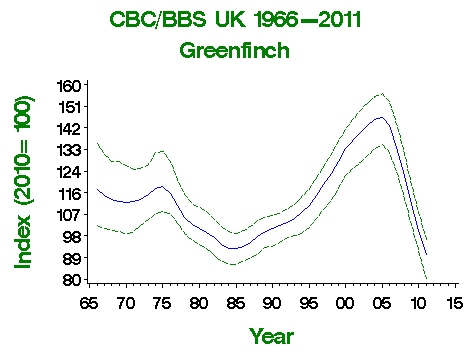
TUESDAY
DECEMBER 17 - 2013
EMSWORTH
HARBOUR
11:30 - 12:30 - High
water at 11:10. I walked from home along Western
Parade to Nore Barn. Men were working on the path to
the west of the Emsworth Sailing Club building, though
it was still possible to walk through. Sea was dead
calm like a millpond with a low watery sun glistening
on the water. A tranquil scene.
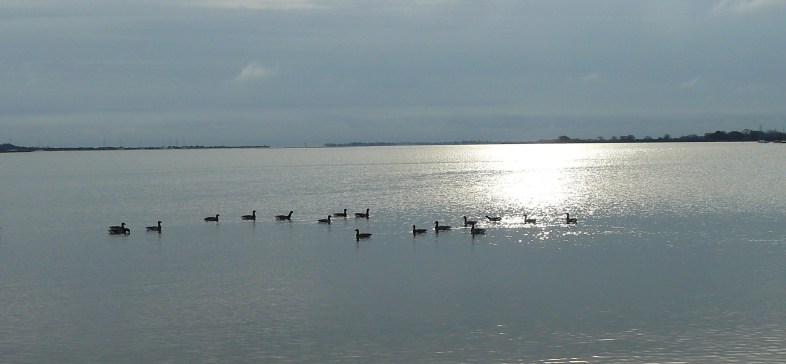
Brent
Geese
As I was walking
towards Nore Barn a large flock of Brent Geese came
over the woods from the fields to the west of
Maisemore Gardens. I had been told by local residents
that Brent Geese had been feeding in these fields,
which clearly has important implications for planning
decisions regarding housing development on the fields.
They all came to rest on the calm water in the creek
south of the woods where I was able to do a rough
count of 620. As I only had my binoculars and one eye
to see with (the other eye still has a patch over it)
aging the birds was not as easy as usual. However, I
managed to age most of the flock and found 24
juveniles.
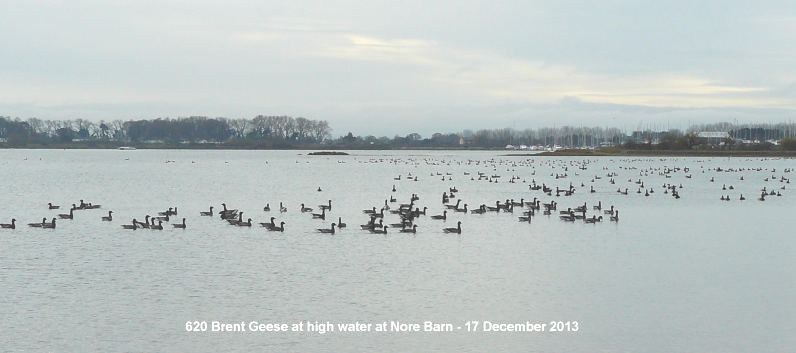
Sandwich
Terns
While at Nore Barn, I
could hear terns calling and spotted at least two
Sandwich Terns flying over the sea, but not fishing.
On Dec 7, Peter Milinets-Raby saw 12 winter plumaged
Sandwich Terns fishing and resting on the buoys at
Nore Barn. On the HOS sightings Andy Johnson reported
16 Sandwich Terns in the mouth of Chichester Harbour
on Dec 14. Ralph Hollins wonders if these all these
sightings represent a new Hampshire record for the
number of Sandwich Terns wintering in the Solent
Harbours, or are they examples of late passage? Ralph
thinks they are passage birds.
BROOK
MEADOW
Chris Oakley took a
walk around Brook Meadow on a dismal, damp afternoon
in the hope of catching sight of the Water Rail, but
had no luck. It is a very elusive bird, it's there one
moment and gone the next. Chris observed that someone
had placed a small Christmas wreath alongside the
memorial plaque on the north bridge in memory of the
two airmen who died over Brook Meadow in the second
World War. A very nice touch, he thought and I agree.

He also discovered a
lovely clump of Oyster mushrooms on a log by
the river and was very tempted to try one but left
them alone. Thanks, Chris. Oyster mushroom is a new
addition to the Brook Meadow fungi list, though I must
admit this list is far from complete. My book says
they are good flavour and firm fleshed and are often
cultivated.
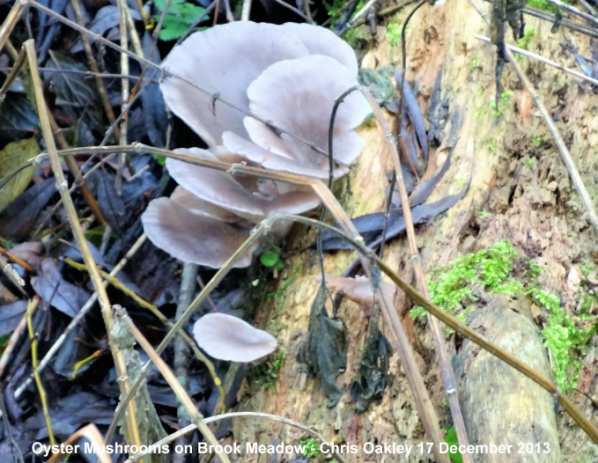
MONDAY
DECEMBER 15 - 2013
Slipper
Millpond
Passing Slipper
Millpond this morning I could see that the wooden
framework on the centre raft had been completed and
what looked like wires wewre stretched across the
whole length of the raft. Two Cormorants were on the
raft, one perched on a cross trestle, so clearly they
have not been detered by the structure.
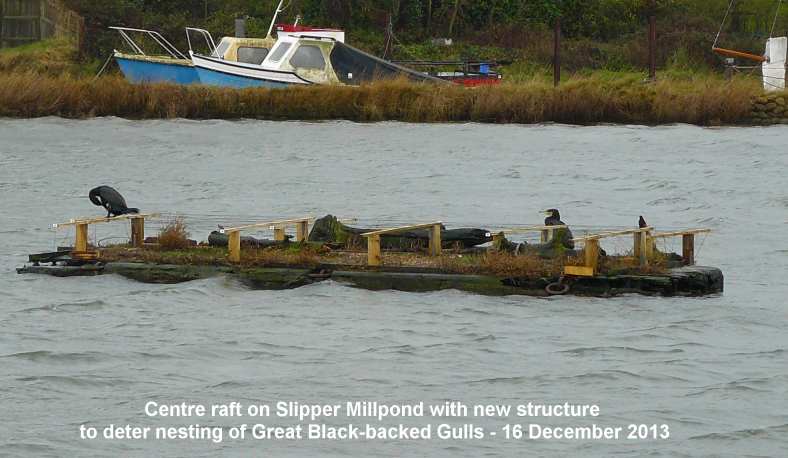
But what about the
Great Black-backed Gulls? There was no sign of them
this morning. However, I had an e-mail from Nick
Medina this to say at 1,30pm he had seen two Great
Black-backed Gulls circling the raft and making a lot
of noise but not landing. So, it looks as if it might
be working.
Here is the design of
the structure from Nick Medina.

SATURDAY
DECEMBER 14 - 2013
Water
Rail
Pam Phillips saw the
Water Rail at 4pm yesterday when it was wet and
gloomy. It was walking along the river bed about 10yds
south of the S bend. When it saw Pam's umbrella it ran
to the bank. Pam saw it there again at 7.30am today
and thinks it must like the twilight. This takes the
total number of sightings this winter to 14. All the
recent ones have been in the area between the
gasholder and the sluice gate.
Nore
Barn to Warblington
Peter Milinets-Raby
did his usual walk this morning from Nore Barn to Pook
Lane and returned via Warblington Church. High tide
(at 9am) forced him to move inland, so it was a
slightly different route than usual, but he visited
all the usual fields etc. Peter started at pre dawn at
7:45am. The sun came up at 7:58am and what a glorious
sunrise it was.
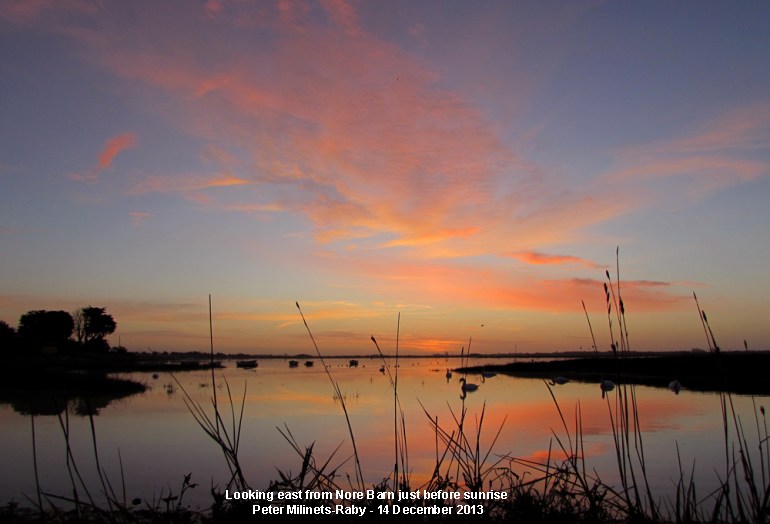
Nore Barn: Tide
pushing in. The Spotted Redshank was initially in the
stream, but left just before the sun came up. 10 Mute
Swans. 132 Teal loafing about on the water. 168 Brent
Geese. 172 Wigeon. Rock Pipit. At the top end of the
Nore Barn channel a flock of 162 Black-tailed Godwits
were roosting until pushed off by a dog. They returned
briefly before moving away to a safer
roost.
Conigar Point:
In the fields behind the point were a winter male Reed
Bunting, 38 Linnets and 19 Skylarks. With Cetti's
Warbler seen along the hedgerow. 22 Shelduck, 8
Pintail, 88 Brent Geese with a nice surprise amongst
them; a Black Brant (probably the Hayling bird,
but I have not seen it or photos so can not be
certain).
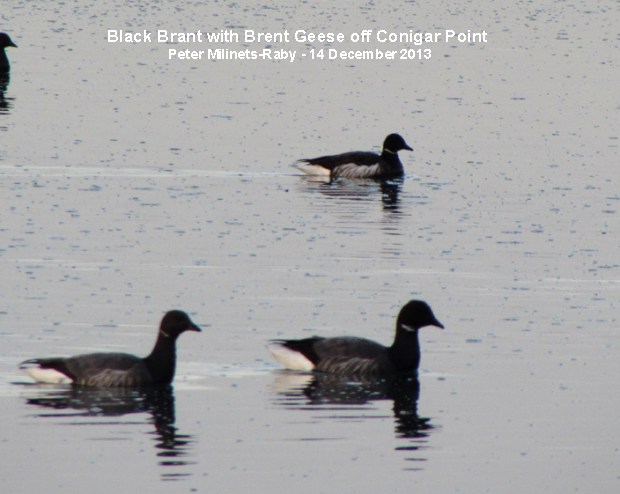
Off Pook Lane:
male Goldeneye, Rock Pipit, 47 Wigeon, 112 Brent
Geese.
Warblington
cemetery: 2 Fieldfare, 6+ Song Thrush feeding the
Yew trees, 3 Mistle Thrushes , 20+ Blackbirds. A Green
Sandpiper and a Grey Wagtail had a brief flight over
the cress beds at Castle Farm.
And there were 39
Curlew, 6 Stock Doves and 6 Meadow Pipits in the big
field on the walk back to Nore Barn. Back at Nore Barn
for 10:20am and only one Sandwich Tern seen plunge
diving.
Editorial
Note on the Black Brant.
There is a good deal
of debate among experts about the identification of a
Black Brant - Branta (bernicla) nigricans. See
. . . http://www.gobirding.eu/Photos/BlackBrant.php
Generally one looks for bright white flanks
contrasting with a very dark belly (there is much less
contrast in the Dark-bellied Brent Goose) and a broad
white neck band sometimes merging at the front.
However, these features are variable in Black Brant
and to complicate matters there are hybrids with
Dark-bellied Brent Geese which are less distinct.
Peter's bird certainly has white flanks, though one
can't see the belly. However, the very narrow neck
band raises the possibility of a hybrid. Here is a
much better example of a Black Brant that Peter took
in January last winter in Southsea.
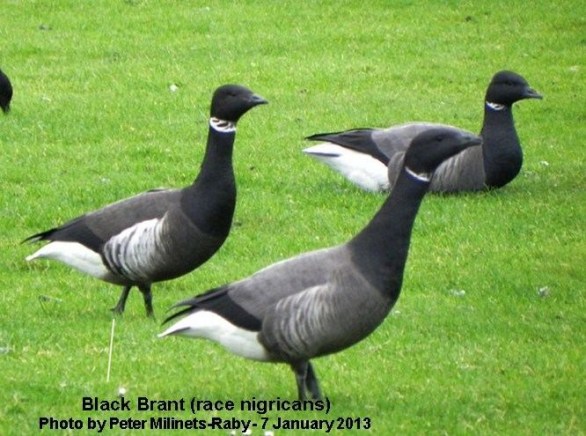
Farlington
Marshes
Romney Turner got some
interesting photos during a walk around Farlington
Marshes recently. Here is a white goose that Romney
has seen several times at Farlington associating with
Canada Geese. This presumably was one of the two white
geese seen by Ralph Hollins on Oct 6. Ralph thought
they were not albino Canadas, though the images on the
internet do closely match the bird taken by Romney.
Ralph said they were present on the reserve last
winter.

Romney also caught
this Black-tailed Godwit in an unusual position. Or is
it practising a synchronised swimming routine?
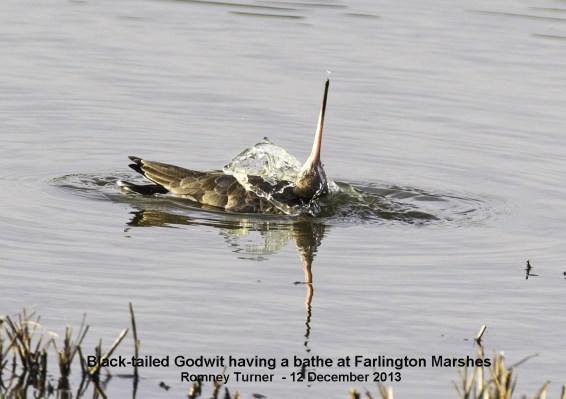
And four Red-breasted
Mergansers in flight.
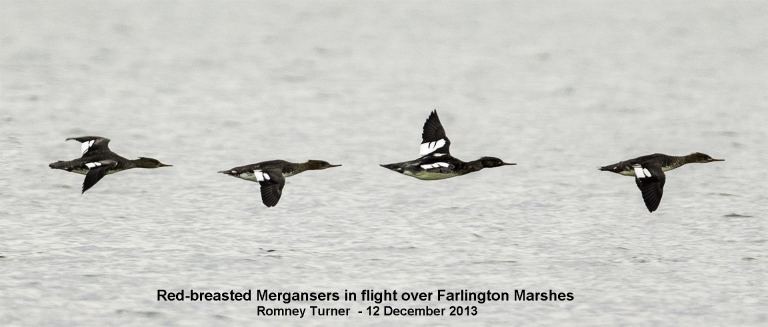
Whisp
of Snipe
Tony Wootton got this
interesting image of a whisp of six Snipe during the
Havant Wildlife Group walk at Titchfield Haven today.
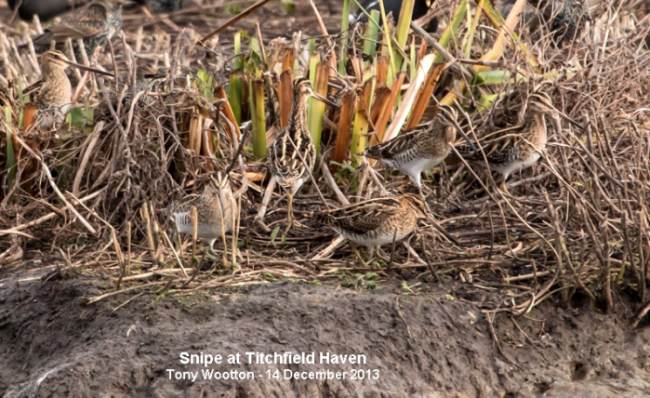
Wikipedia provide a
useful list all the collective names for birds and
other creatures at . . . http://en.wikipedia.org/wiki/List_of_collective_nouns_in_English#S
THURSDAY
DECEMBER 12 - 2013
Brook
Meadow
I am currently
somewhat incapacitated following an operation on my
right eye which has a big patch on it.

The eye is still
patched up but I am feeling more confident about
getting out, so I ventured onto Brook Meadow on this
dull and slightly misty morning which had a watery sun
glinting through the clouds. So peaceful.
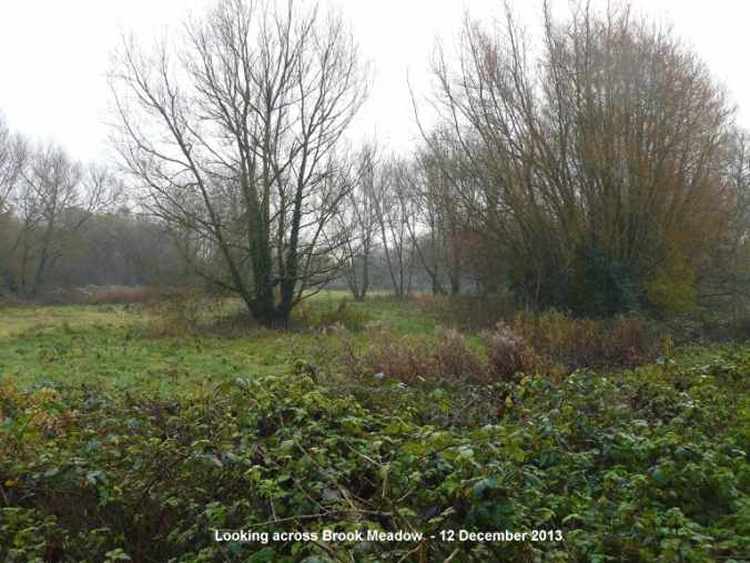
It was so good to hear
several Robins singing their wistful autumn songs in
different parts of the meadow. Even better was the far
bolder strains of a Song Thrush emanating from
the railway embankment. Song Thrush is an intermittent
winter songster and the last one I heard on the meadow
was on Nov 28.
I kept my one eye on
the river bank as I walked down the raised path and
was pleased to get a brief but definite sighting of a
Water Rail scuttling along the edge of the west
bank just north of the old gasholder. It was out for
not more than 15 seconds before it slunk away into the
dense brambles on the bankside not to emerge. No
chance of a photo.
It was good to see the
Cow Parsley still flowering well on the
causeway. Nearby the Gorse bush has several open
flowers.
Slipper
Millpond
Slipper Millpond was
living up to its name this morning, flat calm and
providing a fine array of reflections from the
surrounding houses. This photo is looking south from
the western path towards the mill house.
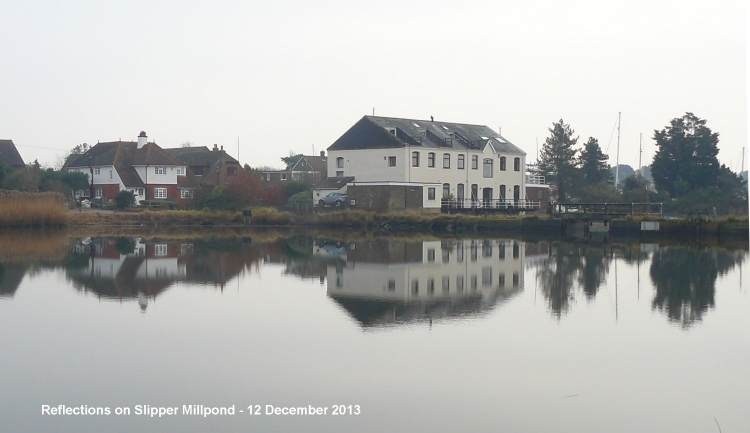
I was interested to
see a couple of chaps from the Slipper Millpond
Preservation Association constructing a low wooden
framework on the centre raft which presumably will
hold some sort of cover as a barrier to the future
nesting of the Great Black-backed Gulls. It will be
interesting to see what has been decided.
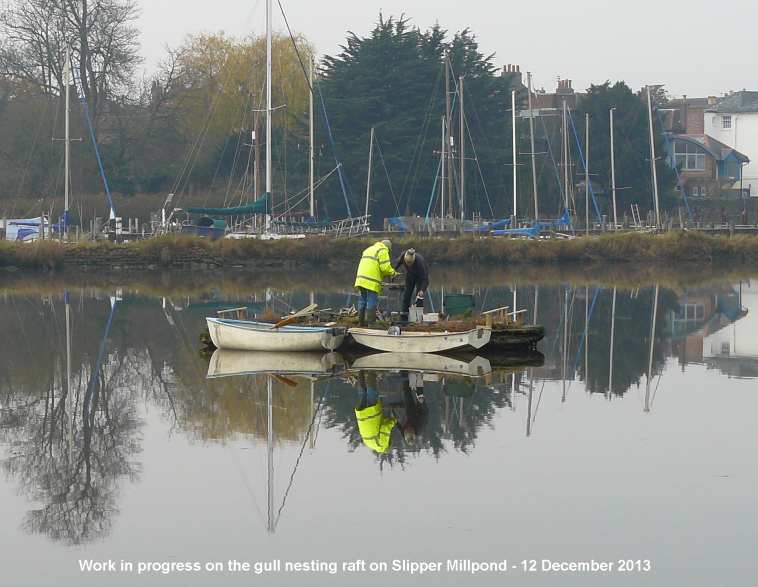
Tony's
news
Yesterday (Dec 11)
Tony Wootton went to Titchfield Haven and photo'd a
warbler which a volunteer warden thought was a Willow
Warbler. This is very unlikely, even at Titchfield
Haven! Willow Warbler and Chiffchaff are notoriously
difficult to separate even when seen very well (except
by their songs); you need to compare the projections
of their primary feathers. But, any warbler of this
nature seen in winter is almost certainly a
Chiffchaff as all Willow Warblers go back to
Africa - sensible birds.

Tony also got this
great shot of a flock
of Dunlin
coming into land on one of the lakes, giving a good
impression of a rather unruly ballet de corps dancing
on air.
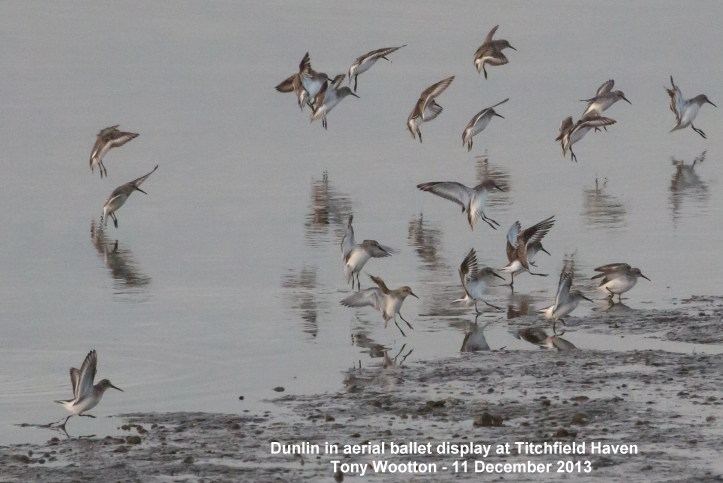
In the afternoon Tony
went down to Thorney Little Deeps hoping for Bearded
Tits but did not see any. However, he did get this
shot of a Black-headed Gull that thinks it's a
Gannet.
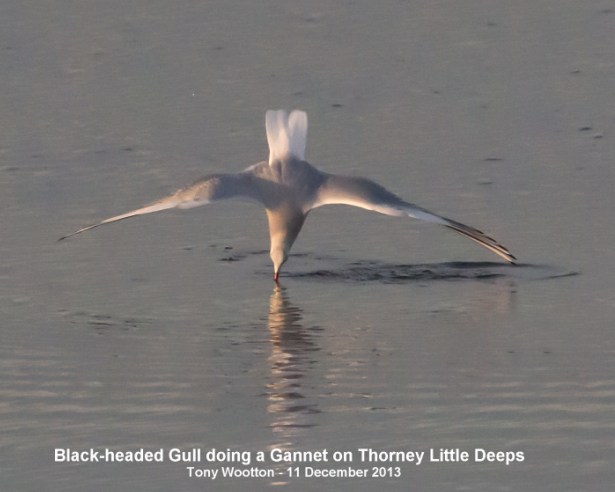
Graham's
Hedgehogs
As reported on Dec 6
the Hedgehog that Graham Petrie's found in his garden
sadly died, but he discovered another one in much
better health which he has named 'Hogboy'. Here is the
latest news up date from Graham about the little
fellow:
"I took Hogboy to the
'Little Prickles Hedgehog Sanctuary' in Portchester
today to get him checked over and have a couple of big
ticks removed from the side of his head. The nice lady
that runs the place said he looked pretty healthy and
was happy with his weight gain. We picked him up a
fortnight ago at 350 grams and he now has a weight of
480 grams. She stated that 650 grams would be ideal
for hibernation. She also confirmed that he is indeed
a male.
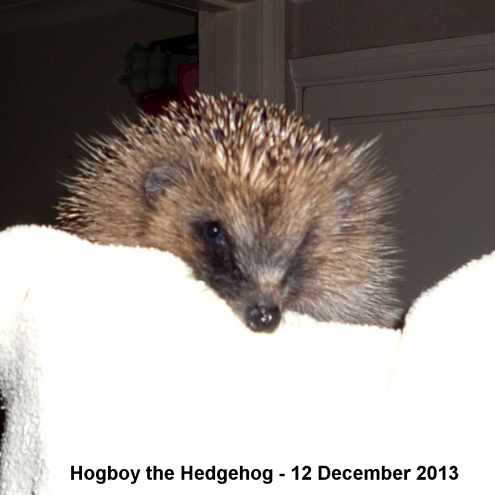
He has coughed a
couple of times today which may be just because he is
a bit dry because of the straw we use for bedding (and
the dust being moved about with the car journey); she
did say that we need to ensure that the coughing does
not become excessive as this would indicate Lungworm
which is easily treated with antibiotic injections
which she is happy to provide if needed. He is also
back inside the house to keep him a bit warmer as the
nights have turned colder and we need to ensure that
he does not hibernate too early while he is
underweight."
Declining
state of UK's birds
The latest State of
the UK's Birds report published recently by the RSPB
shows that many of the most familiar countryside birds
are experiencing 'plummeting population declines',
compared with the 1990s. Of the 107 most common
breeding birds16 have declined by more than one third
since 1995, including Willow Tit, Starling, Cuckoo,
Lapwing, Whinchat and Wood Warbler. Many of these
species are reliant on habitats in the so-called
'wider countryside', rather than being maintained on
special sites such as nature reserves. Of particular
concern is that the numbers of both Grey Partridge and
Turtle Dove have halved since 1995.
However, the report is
not all bad news. Following its reintroduction into
England and Scotland and its ongoing recovery in Wales
the Red Kite has increased by 676 % since 1995. Among
songbirds, the Goldfinch and the Blackcap have also
increased their populations since 1995 by 109% and
133% respectively.
Link . . .
http://www.rspb.org.uk/ourwork/science/sotukb/
Starlings
at Blashford
Following the sighting
of a nice display of Starlings going to roost in
Chichester by Roy Hay (see Dec 6), Trevor Carpenter
has posted a few pictures of a much bigger roost at
Blashford Lakes into his Picasa Albums at the link
below. These photos give some idea of the vast numbers
involved. Counts estimate around 500,000 birds, though
the roosts at Somerset Levels are probably twice that
number. https://picasaweb.google.com/trevorfcarpenter/StarlingsAtBlashfordDec2012#
MONDAY
DECEMBER 9 - 2013
Emsworth
Harbour (east)
11:00 - 12:00 - Low
water. I started on the millpond seawall and walked to
Nore Barn. The tide was pretty well right out. High
water at 16:30.
From the millpond
seawall: 46 Black-tailed Godwits mostly roosting on
the edge of the channel, some feeding on the mudflats.
4 Greenshank busily feeding in the low water channel,
none with rings. One adult Great Black-backed Gull -
probably one of the Slipper Millpond nesting pair. 12
Lapwing on the seaweed islands. 12 Coot. Others
included, Little Egret, Brent Geese (only a few),
Turnstone, Redshank, Grey Plover, Dunlin, Curlew,
Black-headed Gull, Herring Gull.
Emsworth
Harbour (west)
Western mudflats: 23
Black-tailed Godwits, 4 Pintail, Ringed Plover 2
(my first of the winter in Emsworth). Nore Barn:
lots of Brent Geese, Wigeon and Teal. One Common
Redshank in the low water stream.
On the Ivy flowers at
the end of Warblington Road and on the bush just past
the interpretation board in the woods. Plenty of Drone
Flies, Bluebottles and Common Wasps and one
Buff-tail Bumblebee (Bombus terrestris)
with bulging pollen sacs.
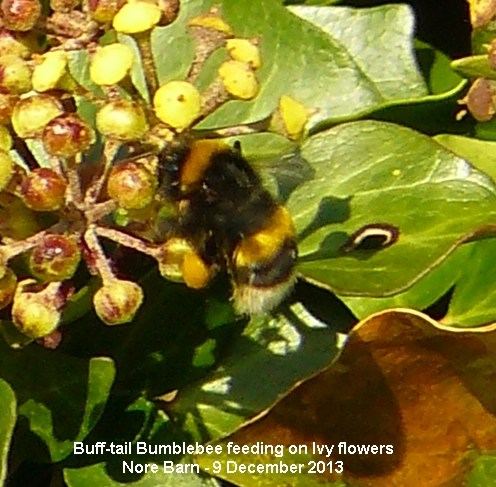
Two Collared Doves
were singing strongly in Nore Barn Woods.
I met Raynor with his
young daughter Rose at Nore Barn. He told me he had
just seen a Red Admiral near the gardens
overlooking the harbour. He also told me he saw a
flock of 12 Common Scoter while canoeing in the
main channel last week.
Other
news
Tony Wootton went to
look for Bearded Tits at Thorney Little Deeps this
afternoon, but saw none and heard none. He did hear
Water Rail and Cetti's Warbler. Tony got this
excellent photo of a small group of Greenshank in
flight.
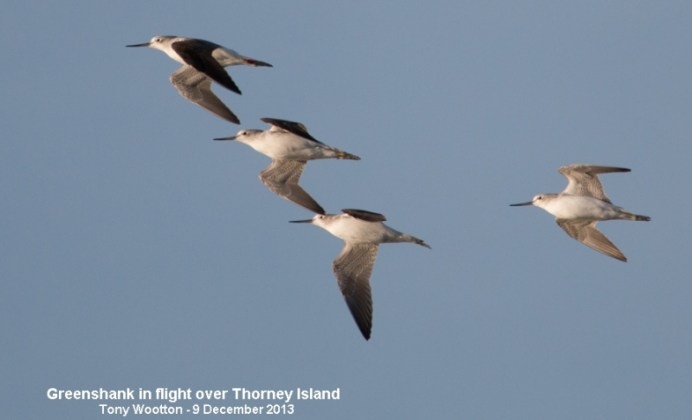
Tony also got this
image of what looks like a juvenile
Sparrowhawk.
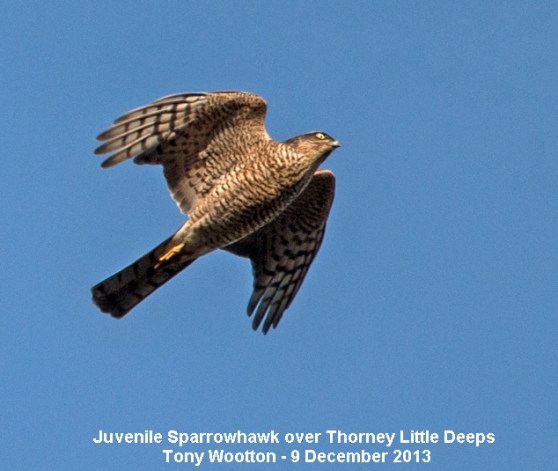
Barry Collins and Margaret had the colour-ringed
Spotted Redshank W+GY at Nutbourne Marshes this
afternoon.
Peter Milinets-Raby sent me a record photo of a
Sandwich Tern perched on buoy - one of 12 that
he saw there on Dec 7.

SUNDAY
DECEMBER 8 - 2013
Dead
worms mystery
Maurice Lillie has
been seeing a large number of dead worms during his
walks around Emsworth. He first noticed them on
Slipper Road, the morning after the high tide two days
ago and thereafter he says they are almost everywhere;
Lumley Road, Main Road and on Brook Meadow. He also
noticed a number of very small fish along the Main
Road side of the Slipper Mill Pond wall. He thought
they must have been victims of the recent surge of sea
water.
Also, on the day after
the surge and the flooding (Dec 6), Pam Phillips
reported dozens of dead worms at the back of
Lillywhite's Garage on the footpath. She also thought
they were drowned during the recent floods.
However, when I put
the question 'Can worms drown?' into Google it came
back with the emphatic answer NO! Here is one
explanation: "Worms breathe through their skin, and
have lots of capillaries circulating blood near the
surface to do this. Being small, they don't usually
have immense air requirements. So usually in the top
parts of the soil where they live there's enough air
for them to get by. Depending on the content of the
water, there may also be plenty of oxygen for them to
get by as well. The interface in a worm's skin can
extract oxygen from fluid about as well as the air. So
if there's enough oxygen in the water (as there
usually is in rain water) it's no obstacle at all. In
fact, worms have been observed to survive in
water-saturated soil for months."
So, maybe, it was the
salt water from the sea that killed them? More
internet research concluded that this was the likely
answer as salt upsets the balance of chemicals just
underneath the earthworm's skin, and dries it out.
Apparently, this is why earthworms are no good for sea
fishing.
SATURDAY
DECEMBER 7 - 2013
Nore
Barn to Warblington
Peter Milinets-Raby
walked from Nore Barn and along the shore to Pook
Lane, then back via Castle Farm and the church at
Warblington (11:35am to 2:30pm with high tide at
2pm).
Nore Barn:
Usual stuff present but no numbers counted due to too
much disturbance. However of note were 17
Pintail, 5 Little Grebes, 2 female Red Breasted
Merganser, 30+ Black-tailed Godwits (one coloured
ring: W - R/WN). Unusually a Grey Plover was in the
pond field with 10 Teal, a Redshank and a Rock
Pipit.
Off Conigar
Point: 170 Teal, Sandwich Tern, 14 Pintail,
511 Brent Geese (most of these flew in from Hayling
and after a wash flew back again), 91 Wigeon, 24
Lapwing, Knot, 3 Dunlin and 7 Grey Plover on last
piece of exposed mud. 14 Shelduck, 7 female Red
Breasted Merganser, Rock Pipit. In fields behind
point, 9 Stock Doves, 1+ Skylarks, 11
Linnets.
Off Pook Lane:
Male Goldeneye, 9 Shelduck, 4 Black-tailed Godwits, 17
Wigeon, 396 Brent Geese grazing in a field here. with
a single Oystercatcher and 7 Curlew.
Warblington
Church: 15 Song Thrush feeding on Yew Tree berries
(probably more).
Castle Farm: 14
Stock Doves. Huge field east of Castle Farm had 14
Curlew and 32 Golden Plover.
When Peter returned to
Nore Barn it was high tide (2pm) and 12 winter
plumaged Sandwich Terns were fishing and resting
on the buoys! Here is one of them.

FRIDAY
DECEMBER 6 - 2013
Nore
Barn
11:30 Tide well in.
Spotted Redshank and Greenshank feeding close together
in the flooded stream.
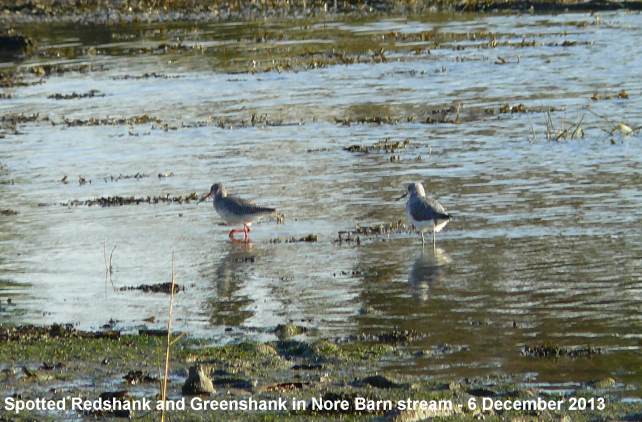
I counted 104
Black-tailed Godwits roosting on the saltmarshes
at the top of Nore Barn Creek. I am not sure if this
is a regular high water roost. Most were either
resting on one leg or in water, but I picked out 3
regular colour-ringed birds: G+BG, G+WR and W+WN.

Wild
flowers
I walked round the
shore towards Warblington to have a look at the field
inside the seawall at Conigar Point where Ralph
Hollins found 14 species flowering on Nov 29. I did
not see that many, but I did find a few to take my
personal December wild flower list to 31 species - see
full list at . . . Winter
flowering plants.
Ralph is still well ahead of me with 50 species up to
Dec 3 from the Havant area.
Particularly
prominent on the Conigar Point field was Field
Woundwort.
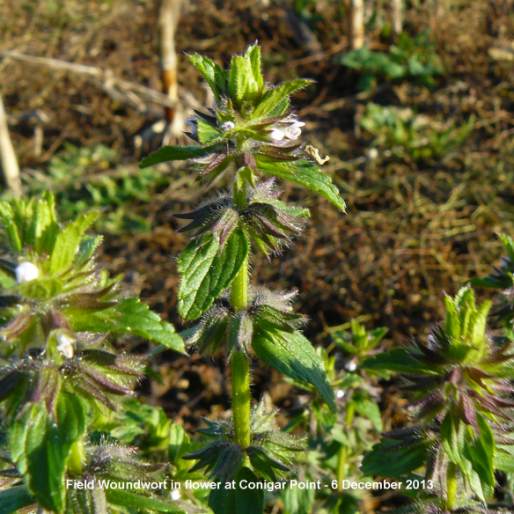
Winter
Heliotrope is now opening its flowers on the A259
embankment
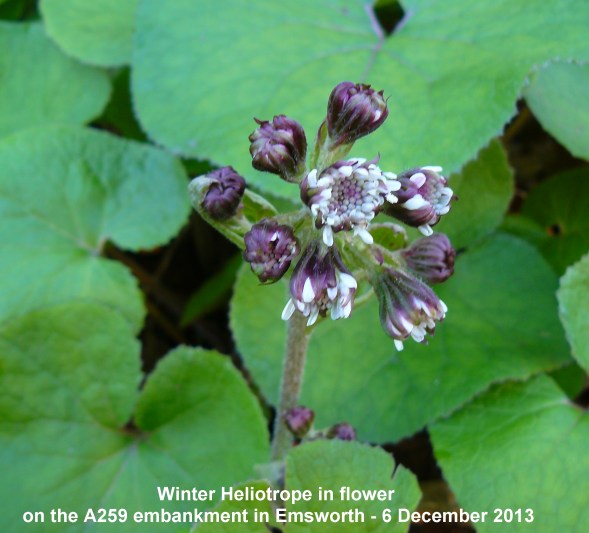
Hedgehog
update
This afternoon I met
Graham Petrie who was on his way back from a guided
Hampshire Wildlife Trust walk down the west side of
Thorney Island, where he had good views of Bearded
Tits at the Little Deeps. He told me that the Hedgehog
he had in his garden (reported here on Nov 29) did not
survive. However, he has another one in his garden
which looked far more healthy and is being housed, fed
and generally tended to by Graham. He believes they
have been disturbed in hibernation by local building
work.
Blackbird
song
On the way home from
the shops in Emsworth at about 1pm this afternoon, I
heard a Blackbird singing from the large Yew tree in
the garden at the bottom of West Street. This was my
first Blackbird song of the winter period. Ralph
Hollins heard his first full Blackbird song on Nov 30
from Southmoor Lane in Havant, so it looks as if they
might be starting up generally. Blackbird
intermittently sings in mid winter, often with a
subdued 'subsong', but does not begin its full
territorial song until mid February.
Pam's
news
Pam Phillips saw a
Water Rail this morning at the back of the
Williams unit just north of the S-bend. She also saw a
Fox on the west bank going along to the industrial
units where all the rubbish is.
She said there was a
lot of water in the south east corner of the meadow
and in the Lumley wet area after last night's sea
surge. At the back of Lillywhite's on the footpath
there are dozens of dead worms, presumably drowned
when the sea came over.
Starlings
display
Roy Hay sent me a
video he had taken of a pre roost flight display by a
large flock of Starlings from Chichester railway
station at about 16.15 yesterday. Quite spectacular. I
had no idea we could see such a good display locally.
Sorry, I cannot include the video in the blog as it is
too big, but I have suggested to Roy that he puts it
onto You Tube.
Here is the link to
the Starlings on YouTube . . . http://www.youtube.com/watch?v=wA_xHXTsQkw&feature=youtu.be
THURSDAY
DECEMBER 5 - 2013
Nore
Barn birds
10:00 - 11:00 - I got
to Nore Barn as the tide was rising to high water in
about 2 and a half hours. There was a very strong and
chilly wind blowing from the north west and I needed
to find a sheltered spot behind the bushes to view the
birds in the harbour. Much as yesterday, hundreds of
birds were massing in the mouth of the stream, a most
impressive sight. They were mostly Wigeon, Teal, Brent
Geese and Black-tailed Godwits along with some
Black-headed Gulls, all of which are represented in
this snapshot.
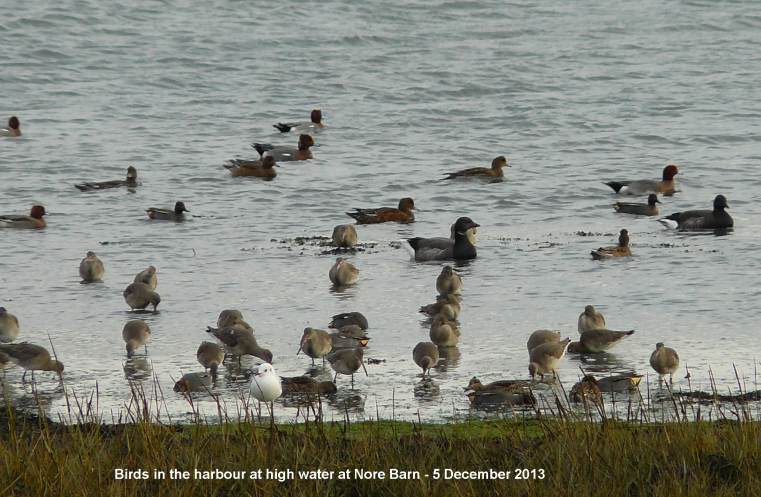
Towards the end of the
session when the tide was really high most of the
Brent Geese went up and flew off towards the
saltmarshes.
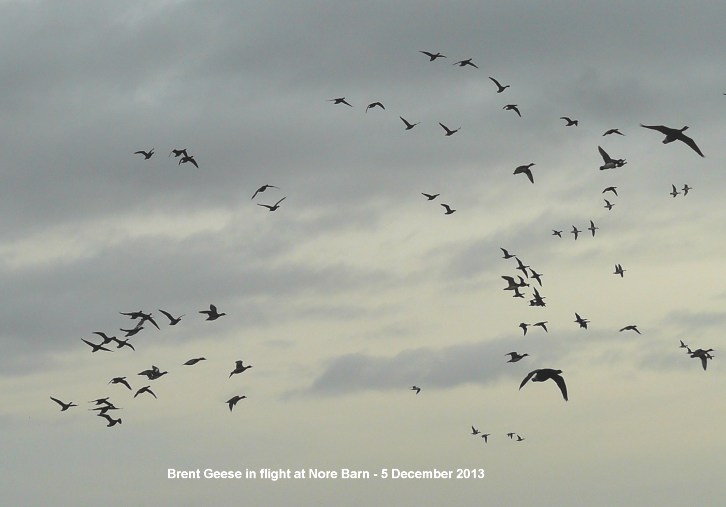
I did not do a formal
count of the godwits, but I would say there were about
the same number as yesterday ie 100+. I also noted 7
colour-ringed birds, all regulars in Emsworth this
winter. This is clearly a steady flock. Three of them
I saw yesterday, W+WN, WO+LW flag and ROL+RLR, plus
three other regulars, G+WR, R+GL, R+LG and R+YN.
Water
Rail on Brook Meadow
Pam Phillips saw a
Water Rail running along the river at 7.30am today. It
headed towards the "S" bend and overtook a moorhen !
Tony Wootton spent a
couple of hours later in the morning and also saw what
was probably the same Water Rail with its two Moorhen
friends near the gasholder. This is the best image we
have had of this winter's bird.
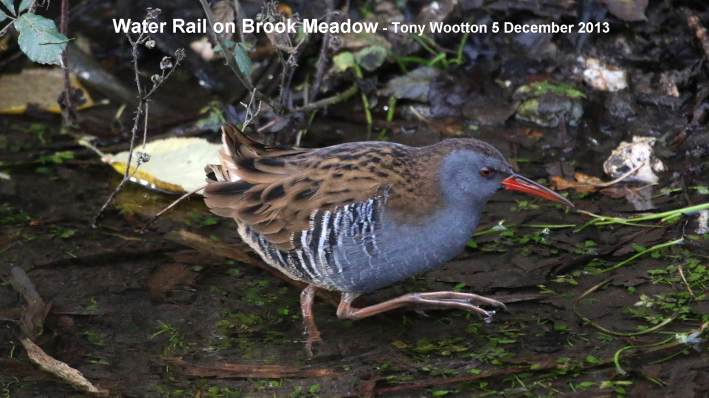
Avocets
at Nutbourne
Tony Wootton also went
to Nutbourne for the Avocets at high water. The tide
was already well in when he arrived and at first
glance there was hardly a bird to be seen. A few
Dunlin, Turnstones, Brent and some lovely Pintails.
Here
are a few Dunlin in flight, showing the characteristic
white wing bars and white edges to rump and tail.
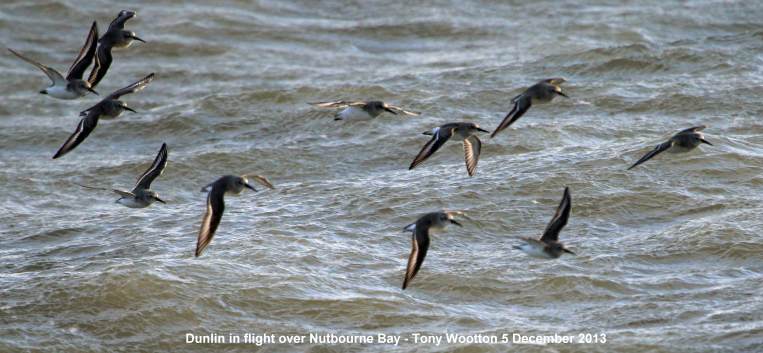
The Avocets were all
together out on the water bobbing up and down. Every
now and again they would fly off to Thorney only to
return. Beaten by the wind? Tony's photo shows 62
birds in flight! That is the best number so far by
far. I suggested to Tony that he submits the sighting
and photo to the SOS Sightings.

WEDNESDAY
DECEMBER 4 - 2013
Nore
Barn
09:30 - 10:30 - I
arrived at Nore Barn this morning with the tide rising
to high water at about 12 noon. It was to be a big one
at 5.0 metres. There were masses of birds milling
around the entrance to the stream with Wigeon, Teal
and Black-tailed Godwits dominating. This photo shows
a few of them in the rapidly filling stream.
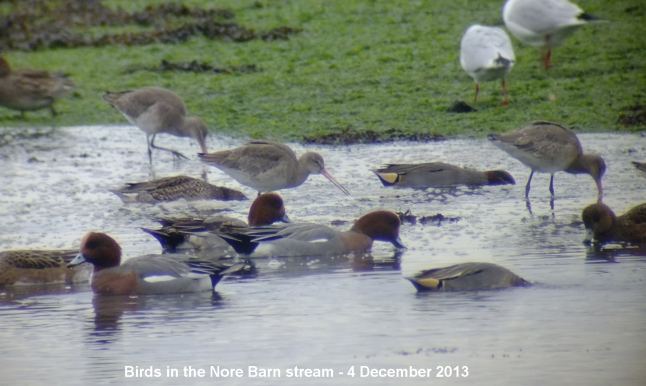
I counted a total of
104 Black-tailed Godwits including four
colour-ringed birds: W+WN and WO+LW flag have been
regularly seen over the past month, but G+BG and
ROL+RLR have not been seen since Nov 5. The latter is
a Kent ringed bird which makes me wonder if they have
been on a trip to Kent, as sometimes happens. I will
check with Dudley Hird the regular Kent godwit
watcher.
I counted 160 Brent
Geese including the two regular families with two
and one juveniles respectively. This takes my breeding
productivity for this season so far to 6.68%.
As the incoming tide
filled up the stream two Spotted Redshanks were
feeding in company with a small group of Mute Swans.
The redshanks appeared to be fairly friendly, though I
did notice some half-hearted chasing from one of them
(presumably the resident) - the one on the left in the
photo. They both flew off together when the stream was
full.
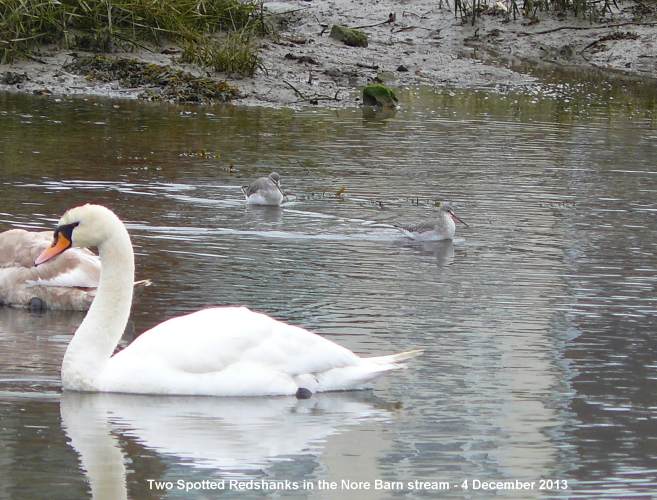
I was interested to
see the Mute Swans drinking the fresh water in the
stream; this must be one of the things that attracts
them (and other birds) to the area.

By the time I left at
about 10:30 the stream was almost full, leaving only
the small herd of 11 Mute Swans swanning in, including
the cygnet from the Peter Pond nest. Such a peaceful
scene.

Brook
Meadow
Malcolm Phillips could
only spend half an hour on the meadow this morning,
but managed to capture this fine image of a Little
Egret perched in a tree. This egret has been a very
regular visitor to the meadow this winter, and can
often be seen (or usually disturbed) in the river.
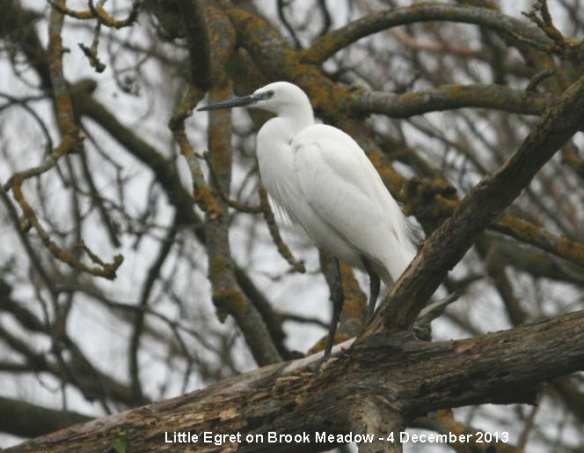
Avocets
at Nutbourne
Barry Collins reported
at least 48 Avocets roosting during the high tide
period in Nutbourne Bay on Dec 1st.
TUESDAY
DECEMBER 3 - 2013
BROOK
MEADOW
Two
Water Rails
After 2 visits to the
meadow today Malcolm Phillips finally got to see not
just one Water Rail but two! They were to the north of
the S bend and both took off flew about 20 yrds up to
the gas holder. Malcolm stood there for about an hour
to get a poor quality photo as the light was very low.
What patience that man has. The two Water Rails
appeared to be quite happy together with two Moorhens.
Malcolm did not manage to get the two Water Rails
together, but here is one swimming quickly.

Cow
Parsley flowers
When I walked through
the meadow this morning I noticed Cow Parsley was in
flower on the side of the causeway leading to the
Lumley gate. The odd plant often does flower at this
time of the year, which could be described as late
autumn or early spring. Ralph Hollins usually sees a
few in flower in the Havant area.
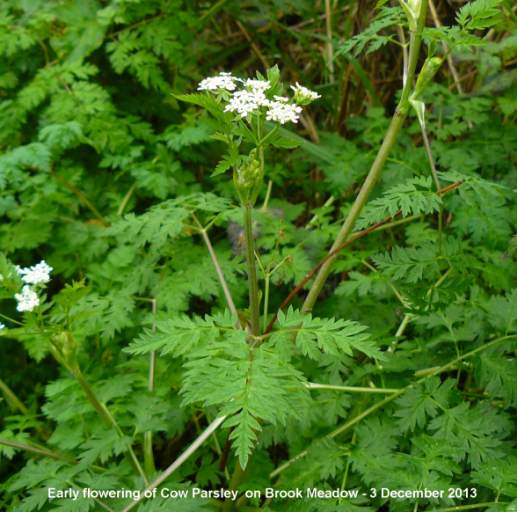
OTHER
EMSWORTH NEWS
Slipper
Millpond
There was a Great
Black-backed Gull sitting on the nest box on the south
raft of Slipper Millpond, presumably one of the
nesting pair.
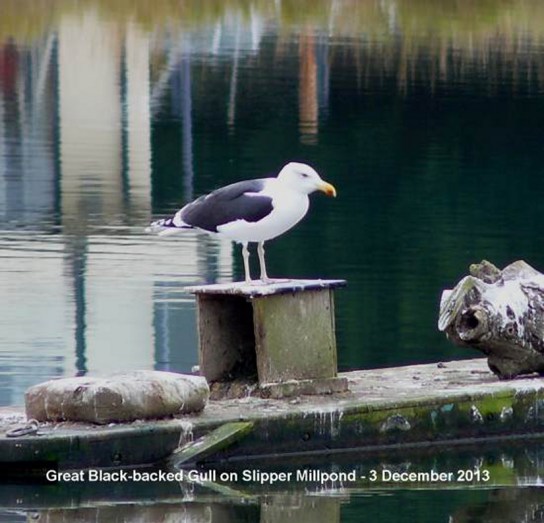
There is no sign of
any work having been done as yet to discourage the
gulls from nesting on the centre raft this year. The
original plan to erect netting over the raft has been
dropped due to the danger of the birds becoming
trapped by the netting. I have not heard any further
ideas.
A Gorse bush is
in full flower on the eastern bank of Slipper
Millpond, its yellow flowers contrasting well with the
bright orange berries of the Pyracantha immediately
behind it.

Emsworth
Millpond
The Mute Swan cygnet
from the 'litter nest' is now looking very good,
despite its rather traumatic early days.
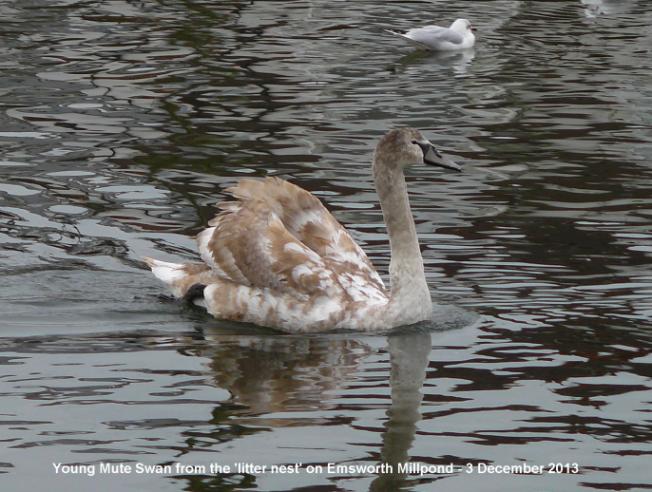
Its parents continue
to patrol the pond with wings raised to deter
intruders. However, this afternoon I noticed a mini
confrontation between the resident pair and a pretty
determined looking invading pair. Clearly, the
resident pair have a fight on their hands.
Here
are two opposing males posturing towards each other.
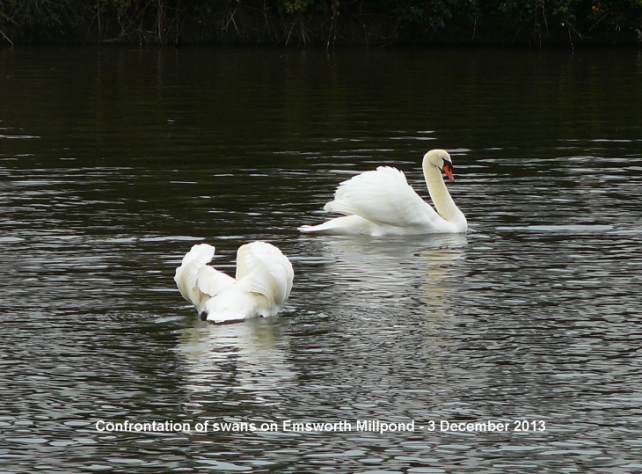
December
flowering wild plants
I noted the following
wild flowers during my walk through Emsworth
today:
Annual Meadow-grass - general
Common Field Speedwell - Palmer's Road Car Park
Common Mallow - Emsworth Millpond
Common Nettle - Palmer's Road Car Park
Cow Parsley - causeway on Brook Meadow
Daisy - general
Dandelion - general
False Oat-grass - Brook Meadow
Germander Speedwell - on south bridge
Gorse - Slipper Millpond
Greater Periwinkle - Lumley Road
Groundsel - general
Guernsey Fleabane - just finished flowering on
Emsworth Millpond
Hogweed - flower heads on Brook Meadow
Ivy - Bath Road
Purple Toadflax - Bridge Road
Sea (Scentless) Mayweed - Emsworth Millpond
Shepherd's Purse - general
Smooth Sow-thistle - general
Wall Barley - Emsworth Millpond
White Dead-nettle - lots everywhere
Winter Heliotrope - just opening on A259 embankment
wayside
Yarrow - prominent here and there.
Small
Tortoiseshell decline - The role of the Sturmia
bella fly
Ralph Hollins points
out that although everyone is delighted with the great
increase in numbers of this butterfly this year, we
should not assume this increase will continue. Ralph
provides a link to a paper summarising the controversy
that is raging among British lepidopterists about the
role played by the Sturmia bella fly in the
decline of the Small Tortoiseshell. See . . .
http://chrisraper.org.uk/blog/?p=283
It has long been
assumed that this fly which is parasitic on the larvae
of Small Tortoiseshell (and certain other butterflies)
is the key factor in its recent decline. However, the
author of the paper Chris Raper concludes "My feeling
is that the Small Tortoiseshell was in decline due to
other constraints (than simply the damage from the
Sturmia bella fly) - possibly a combination of climate
change, habitat destruction and other environmental
problems. When Sturmia arrived it provided an
additional pressure on an already very weakened
population but it is clear that, in Europe (where
Sturmia has long been a common native fly) and in some
regions of England where the population of Small
Tortoiseshell is healthy, Sturmia does not cause a
decline in Small Tortoiseshell numbers. Nor does it
make sense for any parasitoid to wipe out a host - no
host, no parasitoid! I think it is vital that
conservationists to make it clear to decision makers
and the media that the primary reason that we find
ourselves in this position is the same one that we
have been preaching for the last 20 years - man's
adverse effect on the environment. To label parasitism
as a major cause of the decline in Small Tortoiseshell
would muddy the waters and provide the enemies of
conservation with a convenient
scapegoat."
MONDAY
DECEMBER 2 - 2013
BROOK
MEADOW
Water
Rail
I had a walk through
Brook Meadow this afternoon and found the Water Rail
in the exactly the same place that I saw it last time
on Nov 30, immediately in front of the old gasholder.
This was the 7th sighting of a Water Rail on the River
Ems since Nov 15.
Blackbird
with white wing
Malcolm Phillips spent
two hours on Brook Meadow today looking in vain for
the Water Rail. It certainly is an elusive bird if it
can manage to hide away from Malcolm! However, Malcolm
did get some nice images of other birds, including
this male Blackbird with a white wing - partially
leucistic? We have had many sightings on Brook Meadow
over the years of a female Blackbird with white wing
patches, but this one is a male. Such leucism is not
uncommon in Blackbirds.
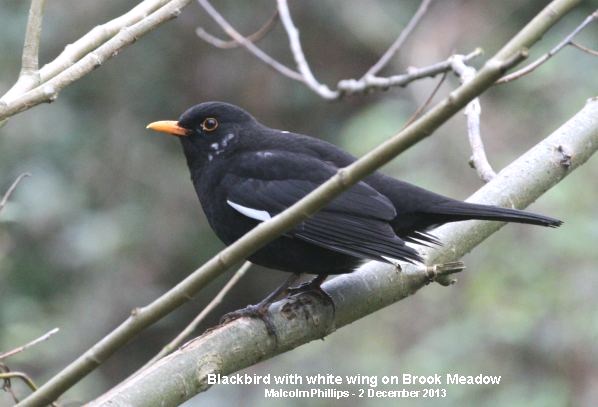
Kingfishers
Ros Norton had two
sightings of a Kingfisher today. The first was on
Brook Meadow flying east to west along the northern
section of the river. The second (almost certainly a
different bird) was perched on reeds on west side of
Peter pond. It flew north east over the pond.
EMSWORTH
MILLPOND
About 100 Black-headed
Gulls along with Mallard and Mute Swans, were milling
around on the eastern side of the town millpond being
fed with bread.

Ringed
Black-headed Gull
I noticed that one of
the gulls had an engraved white ring on its left leg.
I could not read the ring as the birds were constantly
on the move, but took lots of photos and got one
showing the ring and the engraving. It was EAS6. The
right leg had a standard metal ring.
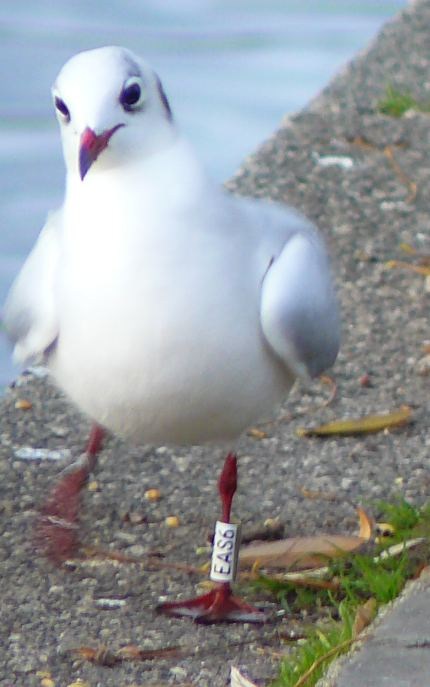
Reporting
the colour-ringed gull
I checked the European
colour-ringed birding web site to see to whom I should
report the sighting. http://www.cr-birding.org/
This led me to a Dutch birdwatcher ringer named Frank
Majoor to whom I e-mailed the sighting
details.
Frank's web site gave
lots of information about his ringing activities as
well as information about recoveries of his ringed
birds. Web site . . . http://www.frankmajoor.nl/
Apparently, most of the Black-headed Gulls which breed
in The Netherlands migrate south (Belgium, France and
Spain) or southwest (England and Ireland). So this one
was probably a Dutch breeder. Frank sent the following
link indicating the wintering destinations of the
gulls that breed in Holland. http://www.petervanhorssen.nl/kokmeeuw_brd/index.html
Ringing
information:
Bird was ringed by Benny Middendorp in Holland at
Zoetermeer, Noordhovense pl on 05-Mar-2012. Since then
it has been seen 9 times in Holland, all in the
ringing area and mostly by Benny. The last sighting
before today's was on 17-Jun-2013. Benny sent me this
photo of the bird in its breeding plumage with a
beautiful brown head.
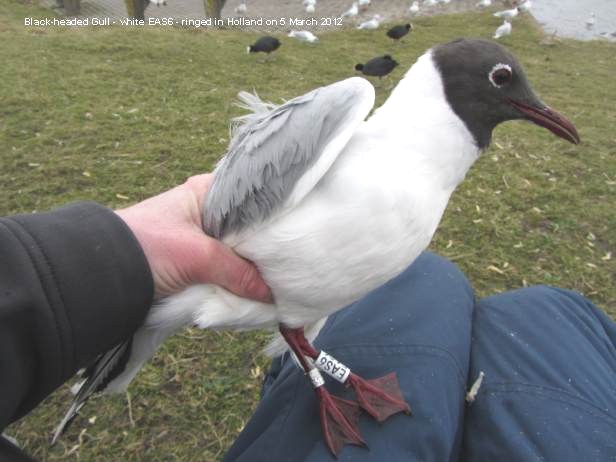
Benny tells me the
bird is a breeding bird from Zoetermeer,
Benthuizerplas which is east of Den Haag.
See picture with islands at . . . http://goo.gl/maps/LYXag
Here
is the site where the gull was ringed. Looks like home
from home?
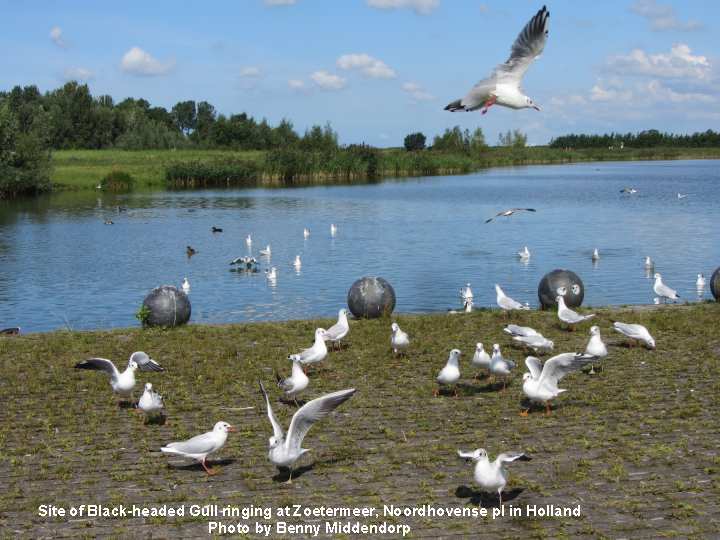
For
earlier observations go to . . November
16-30